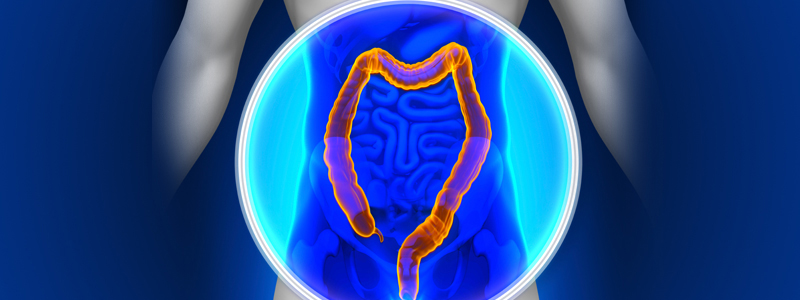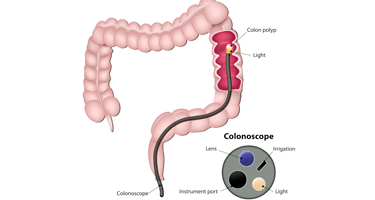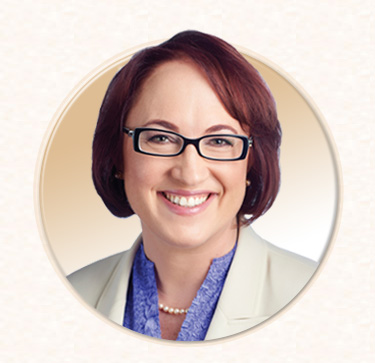Colonoscopy

What Is A Colonoscopy?
A colonoscopy is a diagnostic procedure performed to examine the inside of the colon and rectum. The colonoscopy procedure is performed to determine the cause of changes in bowel activity, abdominal pain, or rectal bleeding, as well as to detect early signs of cancer.
Colonoscopies are recommended every 10 years for everyone between the ages of 50 and 75. They may be recommended more frequently, or at a younger age, for people at elevated risk of developing colorectal cancer (CRC), typically patients with certain medical conditions or with a family history of the disease. Colonoscopies are also performed as a follow-up to other screening tests with positive results, such as a fecal occult blood tests.
Preparing for a Colonoscopy

In preparation for a colonoscopy, patients are given a set of written instructions to follow. While the instructions may differ slightly from one doctor to another, typically patients are instructed to drink two to four quarts of special bowel cleansing solution (laxative) the day before the procedure. An enema may also be required. This preparation, though unpleasant, is necessary to cleanse the bowel so the doctor can visualize the area completely. Medications that act as blood thinners usually have to be temporarily discontinued in preparation for a colonoscopy.
During the day of preparation for a colonoscopy, patients are instructed to eat only gelatin (not red or purple) and to drink only clear fluids, such as water, apple or white grape juice, plain tea or coffee, clear broth, and soft drinks and sports drinks without red or purple coloration. The reason for avoiding red or purple beverages and gelatin is that they could be mistaken for blood during the procedure.
The Colonoscopy Procedure
Before the colonoscopy procedure, a sedative is administered intravenously (with an IV) so the patient is relaxed and comfortable. Vital signs are monitored throughout the procedure. Patients lie on their left side as the colonoscope is inserted into the anus and guided thought the rectum and colon (large intestine) to the opening of the small intestine (cecum). A colonoscope is a flexible, lighted tube that is lubricated before insertion, enables the doctor to carefully examine the lining of the colon and to create and record computer images. If necessary, any polyps are removed for biopsy during the procedure. A colonoscopy usually takes between 30 to 60 minutes, but may take somewhat longer if polyps require removal.
Polyps are removed because they may be malignant or may eventually become so. They are removed by an electrical current passing through a wire loop that cuts them from the colon wall. Once removed, the polyps are sent to a laboratory for microscopic analysis. If the doctor observes a larger growth or tumor, a biopsy of its tissue will also be done.
After the Colonoscopy

After the procedure, patients are kept under observation for up to 2 hours, until the sedative used for the procedure wears off. The patient's reflexes and judgment may be temporarily impaired and driving is not permitted for 24 hours after the procedure. Therefore, patients should make preparations to be driven home by someone else.
Some patients may experience a drop in blood pressure of a change in heart rhythms during a colonoscopy due to the sedative administered, but this also is usually temporary and inconsequential. Because gas has been pumped into the intestinal tract during the colonoscopy, some patients may experience gas pains, bloating or abdominal cramping after the procedure, but these effects, too, are temporary.
If a polyp has been removed during a colonoscopy, the patient may observe a small amount of blood in the stool for a day or two after the procedure. This is entirely normal.
Complications of a Colonoscopy
Complications of a colonoscopy are rare, but, if they do occur, require prompt medical attention. These complications may include:
- Excessive rectal bleeding
- Fever
- Abdominal pain
- Dizziness
- Bleeding from a biopsy site
- Adverse reaction to the IV medication
In extremely rare instances, the intestinal wall may be punctured by the colonoscope, a complication known as a perforation. This complication is suspected if the patient suffers severe abdominal pain, nausea and vomiting after the test. Perforation can lead to dangerous abdominal infection. It is life-threatening and must be repaired surgically.
Our Surgeons Specializing in Colonoscopy

- Aisha Akhtar, MD, FCPS
- Colon & Rectal Surgeon
- Glendale & Scottsdale
- Learn More

- Adrienne Forstner-Barthell, MD, FACS, FASCRS
- Colon & Rectal Surgeon
- Glendale
- Learn More

- Michael Buckmire, MD, FACS, FASCRS
- Colon & Rectal Surgeon
- Mesa & Gilbert
- Learn More

- Ashley R. Casano, DO, FACS
- Colon & Rectal Surgeon
- Gilbert & Mesa
- Learn More

- Tafadzwa Makarawo, MD, MRCS(Ed), FACS
- Colon & Rectal Surgeon
- Glendale
- Learn More

- C. Amir Esparza Monzavi, MD
- Colon & Rectal Surgeon
- Buckeye & Phoenix
- Learn More

- Sushil Pandey, MD, FACS, FASCRS
- Colon & Rectal Surgeon
- Sun City West
- Learn More

- Karthik Raghavan, MD, FACS
- General Surgeon
- Glendale
- Learn More

- Neeraj Singh, MD, FACS, FASCRS
- Colon & Rectal Surgeon
- Glendale, Phoenix & Scottsdale
- Learn More

